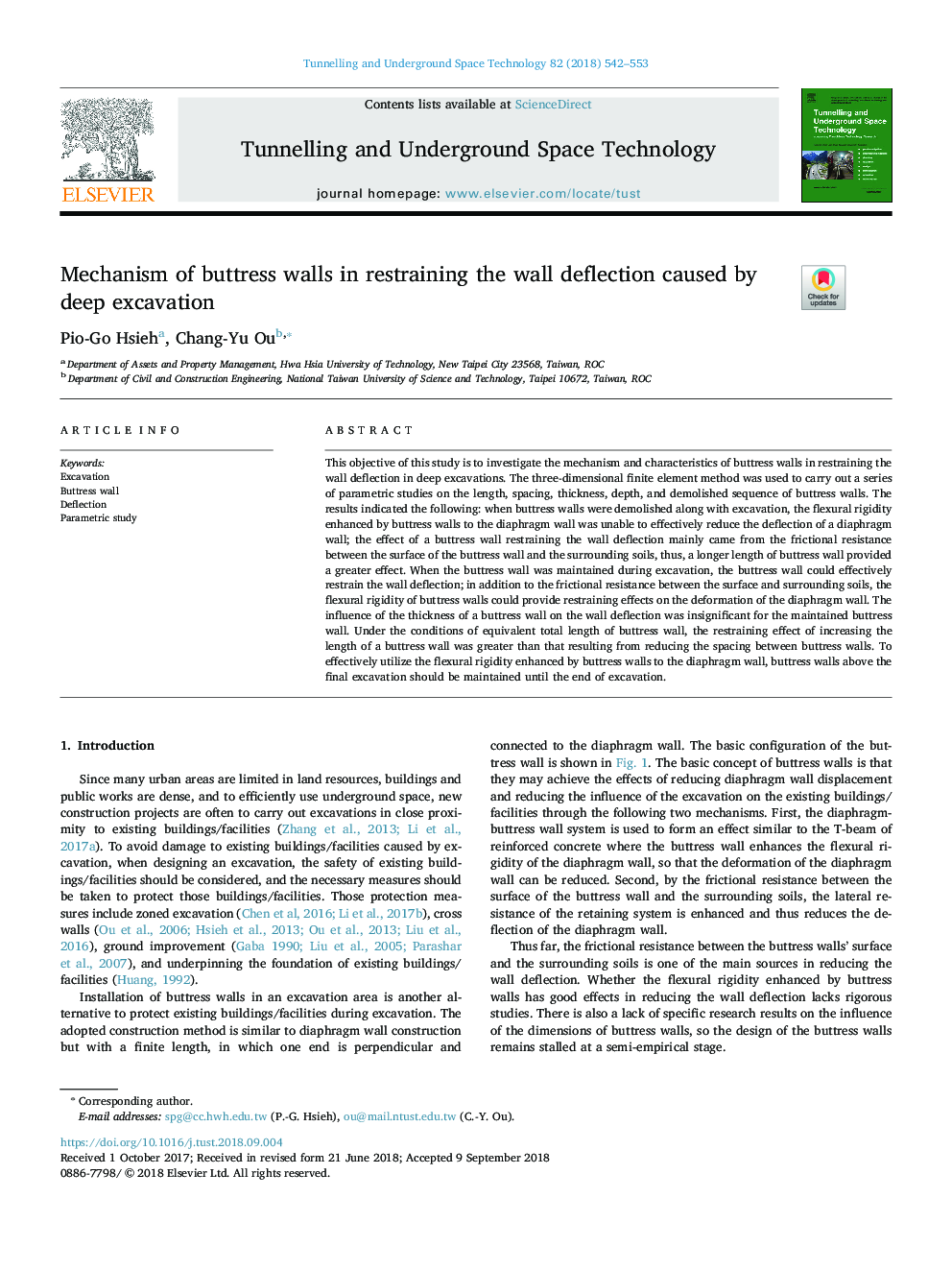| کد مقاله | کد نشریه | سال انتشار | مقاله انگلیسی | نسخه تمام متن |
|---|---|---|---|---|
| 11001378 | 1432264 | 2018 | 12 صفحه PDF | دانلود رایگان |
عنوان انگلیسی مقاله ISI
Mechanism of buttress walls in restraining the wall deflection caused by deep excavation
ترجمه فارسی عنوان
مکانیسم دیوارهای پشتیبانی در محدود کردن انحراف دیوار ناشی از حفاری عمیق
دانلود مقاله + سفارش ترجمه
دانلود مقاله ISI انگلیسی
رایگان برای ایرانیان
کلمات کلیدی
حفاری، دیوار روبرو، انحراف، مطالعه پارامتری،
ترجمه چکیده
هدف از این مطالعه بررسی مکانیزم و خصوصیات دیوارهای محوری در محدود کردن انحراف دیوار در حفاری های عمیق است. برای انجام مجموعه ای از مطالعات پارامتری بر روی طول، فاصله، ضخامت، عمق و توالی تخریب دیوارهای محوری از روش عنصر محدودی سه بعدی استفاده شده است. نتایج بدست آمده نشان داد: هنگامی که دیوارهای محکم در کنار حفاری تخریب شدند، سفتی خمشی که توسط دیوارهای محوری به دیوار دیافراگم افزوده شد، قادر به کاهش اثر انعکاسی دیوار دیافراگم نبود. اثر یک دیواره مخروطی که مانع از انحراف دیواره می شود عمدتا از مقاومت اصطکاکی بین سطح دیوار حمایت کننده و خاک اطراف آن حاصل می شود، بنابراین طولی طولانی تر دیوار محوری باعث افزایش اثر می شود. هنگامی که دیوار کفپوش در حین کاوش نگهداری می شد، دیوار محکم می تواند به طور موثر مانع از انحراف دیوار شود؛ علاوه بر مقاومت اصطکاکی بین سطح و خاک اطراف، سفتی خمشی دیواره های محوری می تواند اثرات مهار کننده ای بر تغییر شکل دیوار دیافراگم ایجاد کند. تأثیر ضخامت یک دیوار حمایت کننده بر روی انحراف دیوار برای دیواره حمایت شده نگهداری نشده بود. با توجه به طول کل معادل دیوار استحکام، اثر مهار کننده افزایش طول دیوار استحکام بیشتر از این بود که باعث کاهش فاصله بین دیوارهای حمایت شده بود. برای به طور موثر استفاده از استحکام خمشی که توسط دیوارهای حمایت از دیوار به دیواره دیافراگم افزایش یافته است، دیوارهای پشتی بالای حفره نهایی باید تا پایان حفاری حفظ شود.
موضوعات مرتبط
مهندسی و علوم پایه
علوم زمین و سیارات
مهندسی ژئوتکنیک و زمین شناسی مهندسی
چکیده انگلیسی
This objective of this study is to investigate the mechanism and characteristics of buttress walls in restraining the wall deflection in deep excavations. The three-dimensional finite element method was used to carry out a series of parametric studies on the length, spacing, thickness, depth, and demolished sequence of buttress walls. The results indicated the following: when buttress walls were demolished along with excavation, the flexural rigidity enhanced by buttress walls to the diaphragm wall was unable to effectively reduce the deflection of a diaphragm wall; the effect of a buttress wall restraining the wall deflection mainly came from the frictional resistance between the surface of the buttress wall and the surrounding soils, thus, a longer length of buttress wall provided a greater effect. When the buttress wall was maintained during excavation, the buttress wall could effectively restrain the wall deflection; in addition to the frictional resistance between the surface and surrounding soils, the flexural rigidity of buttress walls could provide restraining effects on the deformation of the diaphragm wall. The influence of the thickness of a buttress wall on the wall deflection was insignificant for the maintained buttress wall. Under the conditions of equivalent total length of buttress wall, the restraining effect of increasing the length of a buttress wall was greater than that resulting from reducing the spacing between buttress walls. To effectively utilize the flexural rigidity enhanced by buttress walls to the diaphragm wall, buttress walls above the final excavation should be maintained until the end of excavation.
ناشر
Database: Elsevier - ScienceDirect (ساینس دایرکت)
Journal: Tunnelling and Underground Space Technology - Volume 82, December 2018, Pages 542-553
Journal: Tunnelling and Underground Space Technology - Volume 82, December 2018, Pages 542-553
نویسندگان
Pio-Go Hsieh, Chang-Yu Ou,
